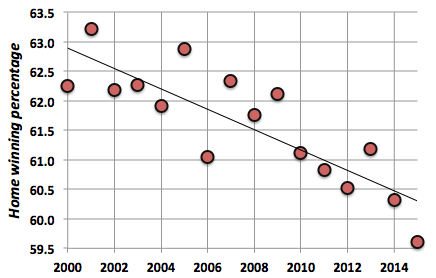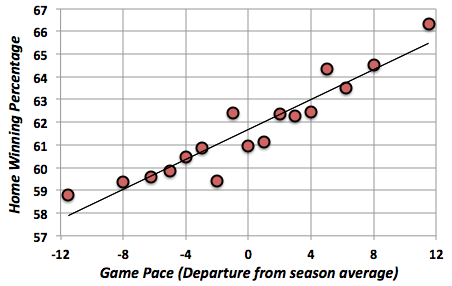There has been recent discussion over at ESPN.com regarding the decline in home court advantage in the NBA. First, there was this piece by Tom Haberstroh, inspired by Steve Ilardi, and then additional analysis by Haberstroh and Kevin Pelton.
It turns out the same effect exists at the college level. Here’s the evolution of home winning percentage (conference games only) since the 2000 season:

The trend is unmistakable: Home teams are winning fewer games than they did 15 years ago. About 2.5 percent worth in absolute terms. This mimics what’s happening in the NBA and one can imagine that an analysis going back farther would show that, as with the professional level, this trend extends farther back in time. It’s interesting that nobody, to my knowledge, has offered a theory that it’s easier to win on the road than it used to me and yet it’s clearly happening. Then again, if we can’t see home court advantage in an individual game, it’s not surprising we wouldn’t notice how it changes over time.
Through Sunday’s games, home teams in conference play have gone 1114-753 for a winning percentage of 59.7. This should rebound a bit, but with less than a month left in the regular season it’s possible that figure will finish below 60 percent for the first time in a long time. (Probably ever, realistically, but it’s not something I have the data to prove at the current time.)
It’s a challenge to determine what might be causing the changes, and Haberstroh offered his own theories which you should read for yourself, but I think there are two primary sources for the college trend.
First, travel has gradually become easier across the college game. As athletic budgets continue to outpace inflation with the seemingly endless stream of TV money coming into the sport, programs have been able to upgrade their mode of transit accordingly. Teams that previously bussed everywhere are taking more flights. And teams that used to depend on commercial flights are taking more charters.
Across the college hoops universe, this is something that would steadily improve over time, fitting with the evolution of the trend we see. It is not difficult to find tales of how chartering makes it easier to battle the road. There’s this piece about Butler, or this one from Arizona, or this from Baylor. And there’s this one with Nebraska head coach Tim Miles comparing the charter life at Nebraska to the commercial flights that were common at Colorado State.
It’s unanimous: Traveling by charter is preferred to traveling commercial. (I wouldn’t know.) Even though this is one of those things that can’t be measured, it’s hard to argue that there’s not some advantage to be gained as travel to road games becomes less time-consuming.
The other factor that appears to be playing a role in reducing home-court advantage is the decreasing pace of play. Fewer possessions could mean fewer chances for the home team to exert its advantage. Data from the past 15 seasons shows a relationship between pace and home court winning percentage.

Each dot represents the average of 1500-2000 games at the pace indicated and this data is normalized within each season, theoretically allowing us to see whether the long term trend of pace and home-court advantage is related or coincidental. It appears to be related. For every change of five possessions in pace, there’s a change of about 1.6 percent in home court winning percentage. That explains a little over half of the change observed in the past decade and a half.
Haberstroh offered a few other possibilities including the decreasing enthusiasm of home crowds and fairer officiating. The interesting thing about the trends in NBA home-court advantage is that it seems to follow the evolution in the game’s pace as well. The massive decline in home-court advantage in the mid-’90s coincided with the pace crash that occurred in that era, as well. And, at least until this season, the NBA’s home court winning percentage was fairly stable over the past two decades as pace stabilized.
Pace and travel aren’t the only two factors that affect home court advantage. Presumably, crowd size and officiating plays a role. And there’s a consistently higher home court advantage for teams that play at altitude. However, pace and travel are things that have been changing over time, and thus are candidates to explain the increasing success of road teams. But this is a complicated issue with many avenues of future research.

